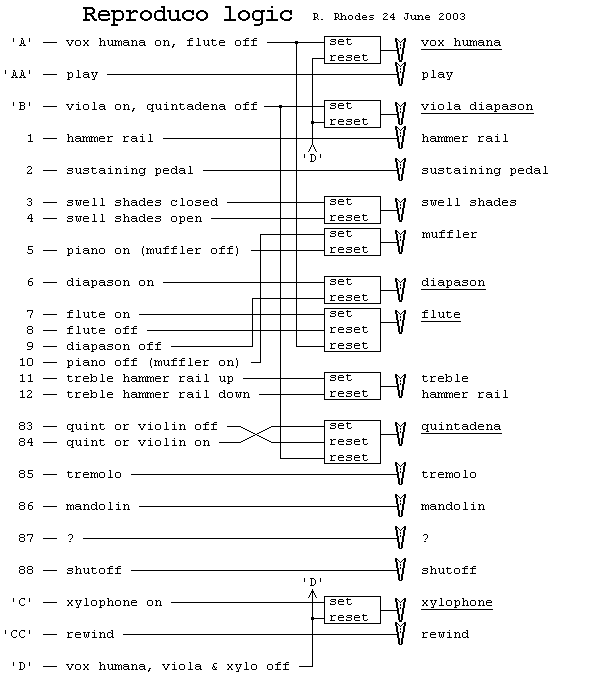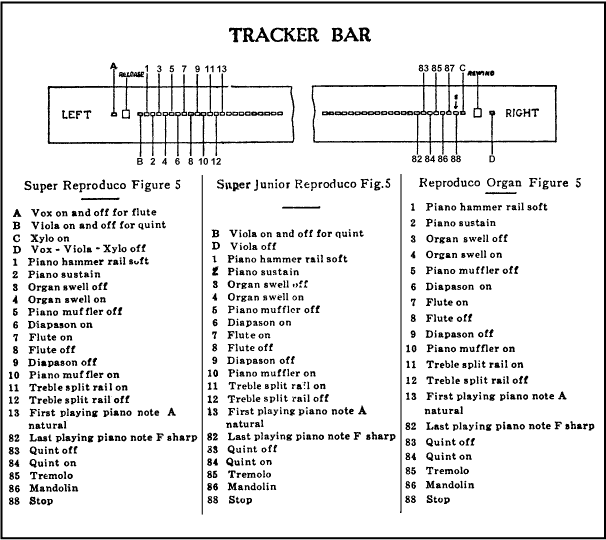| You Are Not Logged In | Login/Get New Account |
|
Please Log In. Accounts are free!
Logged In users are granted additional features including a more current version of the Archives and a simplified process for submitting articles. |
|
MMD
 Gallery
Gallery
 Tech
Tech
 reproduco
reproduco
|
|
mfd. by Operators Piano Co. compiled by Robbie Rhodes data courtesy Hal Davis, Art Reblitz and Don Teach
The basic "Reproduco" model may be described as a piano that also includes one full rank of 61 flute pipes plus a short rank of 37 quintadena pipes. Similar instruments were also made by Wurlitzer and Seeburg. Operators Piano Co. also built the "Unified Reproduco" player organ that played music rolls of 15.25 inches width. Styles OS and NOS music rolls (11.25" wide, 9 holes/inch) for the Reproduco piano-organ were supplied primarily by Columbia/Capitol. 10-tune rolls similar to Coiniola style 'O' rolls were offered, as well as single tunes mounted on player piano style spools. The playing notes are on channels 13 to 82.
Don Teach examined a Reproduco which uses channel 87 to control an accenting device. Some late production style 'O' rolls use a similar channel to accent the cymbal. A Coinola SO orchestrion (that plays the style 'O' rolls), displayed in the legendary Svoboda's Tavern in Chicago, was equipped with a little pneumatic that exerts additional force to aid the reference spring on the suction regulator (at the vacuum reservoir), which causes the regulated suction to increase throughout the instrument. Tony Marsico reports that a Super Reproduco he examined had an original mandolin device installed just like seen in most Coinola instruments, using hard wood paddles struck by the hammer shanks. The device is shifted sideways to enable or disable it. Reproduco:
Super Junior Reproduco:
Super Reproduco:
Art Reblitz describes the disposition of the pipes in the Reproduco: There is a continuous scale of 61 flutes, starting
with the 12 stopped flutes on the back (C-B), the next 12 stopped flutes
inside the case (C-B), and the remaining 37 open flutes in the treble (middle
C-C).
The Reproduco has a "piano muffler," a big pneumatic that lifts the hammers all the way to the strings to mute the piano. Almost all OS/NOS rolls keep it actuated all the time, so the piano hardly ever plays. Collectors often swap the control tubes so the piano will play most of the time. Reproducos are musically fun and versatile, and a good way for a beginning collector to have an instrument with pipes at relatively low cost. Art writes that enjoyable audio recordings of Reproduco music are included in "Speakeasy and Silent Movie Pianos, Vol. I.", available from Marion Roehl Recordings, http://www.mrrecordings.com/ Reproduco Piano-Organ -- Instructions and List of Parts MIDI file (59 kb) of "Yes! We Have No Bananas", piano roll QRS 2272, played by Pete Wendling. The MIDI file arrangement is adapted to sound a little bit like a Reproduco with xylophone. Many tracker scales and key frame layouts are included in "The Golden Age of Automatic Musical Instruments," copyright 2001 by Arthur A. Reblitz, and in "Treasures of Mechanical Music," copyright 1981 by Arthur A. Reblitz and Q. David Bowers.
29 June 2003 |
|
|
|
|
|
|
|
|
|
CONTACT FORM: Click HERE to write to the editor, or to post a message about Mechanical Musical Instruments to the MMD Unless otherwise noted, all opinions are those of the individual authors and may not represent those of the editors. Compilation copyright 1995-2026 by Jody Kravitz. Please read our Republication Policy before copying information from or creating links to this web site. Click HERE to contact the webmaster regarding problems with the website. |
|
|
||||||
|

